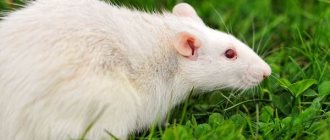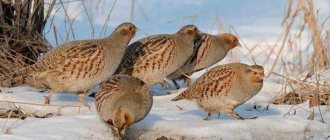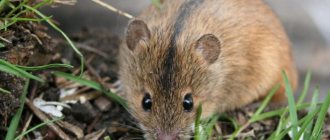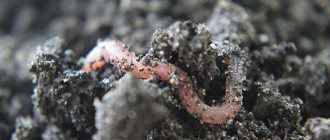Rat nutritional features
Rats are omnivores, but each species has its own preferences. Some people eat more plant foods, seeds, vegetables, and fruits. Others prefer insects, mollusks, and small invertebrates. For example, the diet of a gray rat always contains animal protein, fish and amphibians, mollusks, small rodents and insectivores. From plant foods, rats feed on seeds, grains, and succulent parts of plants. Near a person they find all available food products, waste, livestock and poultry feed. There are practically no stocks.
A rat consumes 20-25 g of food per day, and 7-10 kg of food per year. Rats endure hunger very hard; without food they die on the 3-4th day. They die even faster in the absence of water. A rat usually drinks 30-35 ml of water per day, 5-10 ml if wet food is available.
Use as pets
Thanks to their natural intelligence, rats are easy to train. Most often, gray rodents become pets.
Caring for rats is not difficult. The animals are friendly and clean, but when feeding your pets you should follow moderation and listen to the advice of specialists and a veterinarian.
Important! Such rodents should not be kept alone. These animals are accustomed to living collectively; they feel good only in the company of their relatives.
Common types of rat
Gray rat, or pasyuk (Rattus norvegicus)
Body length without tail is 17-25 cm, weight 140-390 g. The tail is shorter than the body, up to 19.5 cm in length. The muzzle is blunt and wide, the ears are small. The color is gray with red in adults. The hair on the abdomen is white with dark bases. Sometimes there are black individuals.
The species is distributed on all continents except Antarctica. Eastern Asia is considered the homeland of the gray rat, from where they passively settled mainly on sea vessels.
Tan Rat (Rattus adustus)
Endemic to the island of Engano, which is located 100 km southwest of Sumatra (Indonesia). Outwardly it resembles a gray rat, but is more red in color.
Kinabuli rat (Rattus baluensis)
The species is found in Malaysia in northern Borneo at altitudes of 1524-3810 m above sea level. Lives in mountain and moss forests. Outwardly similar to a gray rat.
Black rat (Rattus rattus)
Smaller in size than the gray rat. Body length is 15-22 cm, weight 132-300 g. The tail is covered with dense hairs, longer than the body. The muzzle is narrow, the ears are large and round in shape. There are two color options:
- dark or black-brown above with a greenish tint of guard hairs; light sides; ashy or dirty gray tummy;
- on top the color is like that of a gray rat, but lighter and yellower, the tummy is whitish or yellowish.
Southern forms are usually larger and lighter in color than northern ones.
The species is cosmopolitan, distributed in Europe, Asia, Africa, America, and Australia.
Australian swamp rat (Rattus lutreolus)
Body length 12-20 cm, tail length 56-150 mm, weight about 115 g. The coat is gray-brown or dark gray on top, the belly is usually lighter, from brown to cream color. The hairs have golden tips. The ears are small and invisible in the fur. The tail is scaly with sparse hairs.
The species is found southeast of Fraser Island and south to Kangaroo Island, Tasmania, Bass Strait Islands, Queensland, up to 1600 m above sea level.
Long-haired rat (Rattus villosissimus)
Endemic to central and northern Australia, where it lives in arid or desert areas. Outwardly similar to a black rat.
Small rat (Rattus exulans)
The body is short, the muzzle is pointed, the ears are large, the color is brown. Body length is from 11.5 to 15 cm (without tail), the tail is thin, with “rings” on the surface. The length of the tail is equal to the length of the body. Weight is 40-80 g.
This is the third most common species of rat in the world. Indonesia is recognized as its homeland, from where the small rat was distributed throughout Southeast Asia and Oceania. Lives in steppes, fields and forests. Kept as a pet.
Range, habitats
Rats, which are widespread representatives of the Mouse family, appeared as a species long before humans. Representatives of the numerous genus of Rats live almost everywhere. Different species are found in Europe, inhabit the countries of Asia, South and North America, live in Oceania and Australia, New Guinea and the islands of the Malay Archipelago.
However, such rodents cannot be observed en masse in the subpolar and polar regions. In central Russia, there are mainly two species of rats: gray and black. If necessary, within a day, an adult rat is quite capable of covering a simply enormous distance, reaching fifty kilometers.
The rat knows how to adapt to very difficult, almost unbearable living conditions, which is why they can be found even at abandoned scientific stations in Antarctica.
Return to content
Rat behavior
Rats lead a terrestrial or semi-arboreal lifestyle. In order to hide, they use burrows, which they dig themselves or by finding abandoned empty burrows of other animals. They live either alone or in family or territorial groups. There are up to several hundred or thousands of individuals in colonies. There is a hierarchy within the group. The colony occupies an area of up to 2000 m2, and marks it with scent marks.
Rats are active at night and at dusk. They often settle next to a person and easily adapt to his activity.
Lifestyle
Rats are the most common animal in the world. They are not found only in the Arctic and Antarctica. These rodents are characterized by group living, with hundreds of individuals in one family. The community is controlled by an alpha male and 2-3 females. Each group of animals controls a territory of up to 2000 sq.m.
Rat families have specific habitats. Most animals prefer to stay close to humans, feeding on leftover food or supplies taken from storage.
Rat breeding
They breed throughout the year, except in northern populations. The gray rat has 2-22 cubs in one litter, on average 8-9, in Malayan species from 3 to 6, in Australian species from 3 to 14
Under natural conditions, rats breed in warm weather, 2-3 times a year, and in heated rooms - all year round, breeding up to 8 offspring. The breeding cycle has a spring and autumn peak.
Pregnancy lasts 22-24 days. Babies weigh 4-6 g and are born naked, blind, with closed ear canals. Stillborn and weak rat pups are eaten by females. Males do not take part in raising offspring. The eyes of rat pups open 2 weeks after birth. At the age of 3-4 weeks they become independent. Females reach sexual maturity at 3-4 months.
The lifespan of rats in nature is from 1.5 to 3 years.
Natural enemies
Rats try to avoid “communication” with representatives of canines and cats, as well as snakes and snakes. Their real enemies are: kites, eagles, owls. If foxes or beavers live in the region where rats live, a real war begins between them and the rodents.
In India, mongooses actively fight toothy pests. Some countries of the world (Japan, Colombia, New Zealand) periodically experienced an overabundance of breeding rats, threatening to destroy the entire harvest. In such cases, cats always came to the rescue, which were specially brought into the country to establish biological balance.
Interesting facts about the rodent:
- Rats cause economic damage as they eat and spoil food and non-food products, damage electrical networks, and cause damage to agriculture. In addition, they are a natural reservoir for many zoonotic and anthropozoonotic infections (plague, tularemia, rabies, typhus, toxoplasmosis, leptospirosis, rickettsiosis). Therefore, many methods have been developed for their destruction - deratization. But rats can adapt to and recognize poisons.
- In the United States, rats bite about 14,000 people every year.
- Since the 19th century, specially bred rats have been kept as pets. They are also bred as “live food” for home terrariums and zoos.
- Rats are the main experimental system in biological and medical experiments. Special laboratory rats were bred for this purpose. They are distinguished by their fast metabolism, unpretentiousness and peaceful nature.
- Rats are considered very intelligent animals; along with humans, they have abstract thinking. In addition, they respond to tickling and produce ultrasonic laughter-like sounds.
- In China, the rat is a symbol of prosperity and the first animal to open the cycle of the eastern horoscope. In Islam, the rat is the embodiment of sensuality, and Hinduism represents the rat as a former demon.
Basic pest control tools
Man has been waging war against rats since those ancient times, when neither tools as such nor the very concept of deratization existed. In those distant times, the most popular and effective method of exterminating rats was biological, that is, using cats, dogs and the rats themselves. Here, humans took advantage of the noted tendency of rodents to cruelty and cannibalism. People artificially created a “rat king.” Several rats were caught and placed in a confined space without food. Rats cannot stand hunger, so after a couple of days they begin to eat each other. The winner, the strongest surviving rat, was fed for some time with weakened relatives in order to finally become accustomed to a certain feeding style. Then this monster was released into the territory to be “cleaned up.” All the work of exterminating rats was done with the hands, or rather, with the teeth of the rats themselves. Simple, like everything ingenious. It is not surprising that the sophisticated and resourceful human brain eventually came up with other ways to combat rodents. Today, any city dweller has a much wider choice of them than a caveman. So everyone can satisfy their preferences.
Rat traps
The most common and simple trap is a regular mechanical rat trap with a spring.
.
There are many modifications, but they all work on the same principle - the spring straightens when you touch the nozzle with bait and the gripping mechanism pinches the rodent's head. The advantages of this method are ease of use, lack of dependence on the electrical network, and ease of installation. The disadvantage of this device is that the mechanism operates blindly once and can easily “miss”. Rats have a good reaction and well-developed intuition, which allows them to dodge danger in time. More reliable traps in this regard are adhesive traps
- they do not allow the rodent to escape, securely gluing the paws to the base of the structure. Another advantage of these devices is that there is no need to remove the corpse from the trap - they are disposable and are disposed of along with the rat.
Poisoned Bait
There are a lot of poisons for rats, both in form and content. Granules, briquettes, liquids - they all have a detrimental effect on rats. Depending on the active substance, the death of the rodent occurs within 1 to 15 days. Poisons with the active substance diphasinon kill rodents slowly. Repeated administration of the drug is required for a lethal dose. Substances containing brodifacoum or bromadiolone act faster; a rat only needs to try the poisonous bait once for it to go to another world. The most powerful rat poison with an immediate effect is based on strychnine, thallium salts, lead, phosphorus, and arsenic. Phosphorus damages bone tissue, arsenic affects the nervous system, and other components cause severe poisoning. Preparations based on zoocoumarins have become widespread for home use. You can always find drugs such as:
- Rat Death;
- Storm;
- Nutcracker;
- Goliath;
- Clean house;
- Mortorat;
- Zookoumarin Neo;
- Hedgehog;
- Ratindane;
- Zernotsin;
- Tsunami Extra;
- Varat.
All these poisons are quite toxic and dangerous not only for rats, but also for people and pets. In addition to the risk of poisoning your pets, there is a risk that death will overtake rodents in hard-to-reach places under wall cladding or tiled lining of water pipes. It is almost impossible to remove corpses from such places without destroying the structure. The smell from decaying animals is unbearable and harmful to health. So when choosing rat poison, consider all the risks! If you are not inclined to risk your health, then it is better to consult a specialist.
IMPORTANT
Companies professionally engaged in deratization, firstly, use special closed-type traps in which the poison is inaccessible to children and pets, and secondly, they use new generation drugs with a mummifying effect. After their absorption, the corpse dries out without the spread of unpleasant odors. That is, specialists remove all risks and provide a guarantee for their work.
The rat is a dangerous, cunning and intelligent opponent. You must be prepared to fight him in every way!
Spraying deterrent chemicals
Rats are wary of any strong odors. And from some people they know well, they simply run away. Among them there are aromas of both plant origin and chemical preparations. Plants include peppermint, tansy, and wormwood. These aromas are commercially available in the form of essential oils, in which the concentration of active substances is significantly higher than that of the fresh or dried plant. They can be used undiluted for spraying around the room. Gardeners and summer residents can be recommended to plant black elderberry around the house and beds. The roots of the plant release cyanide into the soil. However, all parts of the plant contain hydrocyanic acid to one degree or another and are a strong poison for rats. They avoid the danger they know well.
Among chemical substances, rats are particularly disliked by ammonia; however, any insecticides with a pungent odor are suitable for spraying indoors.
Another smell that serves as a signal to escape is the smell of burning wool. Our ancestors, in order to drive rats out of their territory, burned one killed rodent and left it where rats got into the habit of visiting - in a barn, cellar, barn. So to speak, a demonstrative execution for the edification of the entire tribe. To use this ancient method of repelling rats, it is not necessary to catch and kill the animal - you can just as easily set fire to a piece of any natural fur or wool. This source of smell can be left for some time even in a city apartment.
Ultrasonic repellers
Rats communicate with each other using ultrasound, so they react to ultrasonic waves and listen warily to their radiation. If they sense a distress signal, a threat, or obvious danger, they take flight. If the manufacturers of the ultrasonic repeller did not bother to ensure that the signal was exactly the same, then the rats very soon get used to the monotonous impulses and stop responding to them. We must not forget that the rat is not just a very smart animal, but a highly intelligent creature with excellent instincts - it is quite capable of distinguishing a real threat from an imaginary one. At the moment, the market offers a large selection of rat repellers of varying power.
On sale you can find devices designed both for the area of a small apartment and for large-scale industrial premises. One of the most famous brands is the Grad ultrasonic repeller. Various modifications of the installation operate in the range from 500 to 1200 square meters, have a unique sound pattern based on the biorhythms of rodents and are equipped with several emitters that send impulses in different directions. Many models of this brand are capable of operating autonomously, without requiring constant connection to the electrical network. All these models can be successfully used in production. For small apartments, we can recommend a set of three Weitech WK-3523 ultrasonic repellers. Each of the three devices in the set is equipped with a plug and is plugged directly into the outlet as a fumigator. You can use one device or all three in different rooms. Each of them has a repellent area of 45 square meters. The devices operate silently and are designed for round-the-clock operation. You can only check how effectively this product will protect you from rodents empirically. A person approaches the extermination of rats, as well as other everyday problems, with his own standards, principles, and preferences. Of all the methods of controlling rodents, everyone can choose the best one for themselves.
Benefits and harms
Rats are a vital link in every ecosystem. A striking example of this is the role of rodents in the “plant-mushroom” symbiosis. Rodents carry spores, ensuring their “meeting” with the necessary representatives of the flora.
Predatory animals and birds feed on rats. People use large rodents for scientific experiments. Decorative varieties of rats are bred for the purpose of domestication. They are often used in various educational projects and circus shows.
Rats are a necessary part of wildlife. An increase in population affects all elements of the ecosystem. The damage caused by rodents to people is enormous:
- damaged house walls and sewer pipes;
- damaged electrical wiring;
- poisoned crops;
- loss of part of the harvest harvested in storage;
- infection with infections (plague, salmonellosis, leptospirosis, pseudotuberculosis, etc.).
Wild rodents can cause significant damage to an orchard. They move freely through trees, damage the bark, and cause damage to shoots and fruits. Particularly dangerous are gray pasyuki, which have a rare appetite and aggressive character.











